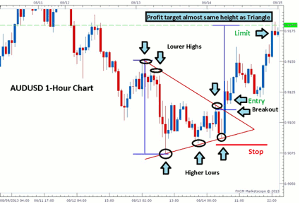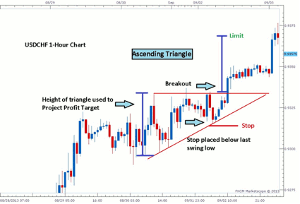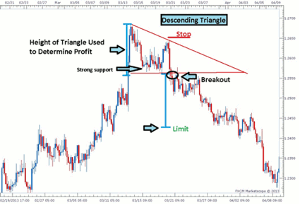With so many currencies to choose from, triangle patterns can help forex traders quickly identify a pair to trade, writes Gregory McLeod of DailyFX.com.
Recognizing chart price patterns is an important aspect of technical analysis that forex traders should master. These patterns act like a highlighter on the chart showing a potential trade. The triangle pattern is one of the most popular price patterns in forex because it is easy to recognize, has a good risk to reward setup, and provides clear and concrete price objectives.
Symmetrical, ascending, and descending are the three types of triangle patterns we will explore today, as well as a strategy on how to trade them.
Symmetrical Triangle in a Downtrend

(Created using FXCM’s Marketscope 2.0 charts)
Click
to Enlarge
The first type of pattern is the symmetrical triangle pattern. It is formed by two intersecting trendlines of similar slope converging at a point called the apex.
In the above example of a symmetrical triangle, you can easily see on the AUD/USD one-hour chart the intersection of a rising trendline and a downtrend line at the bottom of a larger trend. Sellers are unable to push prices lower and buyers can’t push price to new highs.
This coiling of price between support and resistance is called a consolidation. Usually, within the first 2/3 of the triangle, a breakout occurs either above trendline resistance or below trendline support as either the sellers or buyers take control.
Once a triangle is identified on the chart, traders will wait for a breakout either above the resistance trendline or below support. After a breakout is confirmed with either a closed candle above resistance or below support a stop is placed approximately 10 pips below the last swing low of the triangle. A limit equal to the height of the triangle is then placed.
Triangle Breakout with Risk Management

(Created using FXCM’s Marketscope 2.0 charts)
Click
to Enlarge
In the above example, a trader who went long after the clear breakout at 0.9120 with a stop placed at 0.9086 and a limit of 55 pips would have had a profitable trade with a 1.6:1 reward to risk ratio. Though initially, a trader may not know the direction of the move, the triangle pattern alerted traders that a big move was nearby. In my opinion, if the consolidation exceeds 2/3 of the triangle and reaches the apex, price action just goes sideways much like a flat bottle of soda.
The next type of triangle pattern is the ascending triangle. It is easily recognized by a rising trend line intersecting with a flat resistance line. It is often regarded by traders as a bullish pattern characterized by a breaking out above resistance when completed. However, in the ascending triangle pattern, breakouts can take place below resistance. This can especially be the case when the trend prior to the triangle was down.
Ascending Triangle with Breakout

(Created using FXCM’s Marketscope 2.0 charts)
Click
to Enlarge
Similarly to the symmetrical triangle pattern, traders enter short on a break below the bottom of the pattern with a stop approximately 10 pips above the top of the high with a profit objective equal to the height of the pattern. However, if price rallied above resistance, a stop would be placed below the highest low within the pattern with an additional cushion of approximately 10 pips.
The last triangle pattern is the descending triangle pattern. The descending triangle is characterized by an area of strong support intersecting a downward sloping trend line. When chartists see this pattern as part of a larger downtrend, they look for a continuation of the downtrend. A close break and close below the area of support would be a confirmation of this pattern signaling traders to enter short with a stop above the top of the pattern.
Descending Triangle with Breakout

(Created using FXCM’s Marketscope 2.0 charts)
Click
to Enlarge
The triangle pattern represents the forces of buyers unable to push price higher and sellers struggling to push price lower. Usually, the struggle is resolved with a breakout below support as illustrated in the example above.
In sum, triangle patterns are easy to spot and provide good risk reward opportunities. Traders can quickly know that a big move may be near, as well as the profit objective and the amount to put at risk. Now that you have the knowledge of the three powerful price patterns you are steps closer to becoming more confident trader!
By Gregory McLeod, Trading Instructor, DailyFX.com










